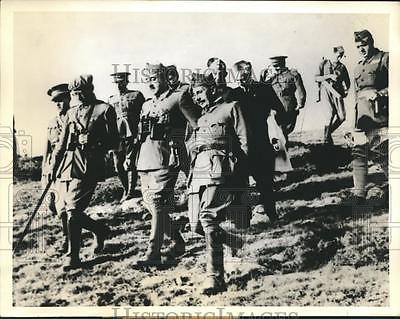
August 22
Nationalist forces take the areas of Selaya, Villacarriedo, Ontaneda and Las Fraguas in the Cantabrian region as they advance towards Santander.
August 23
Navarrese forces fighting for the Nationalists claim Mazcuerras Valley and take Mount Ibio, which all-but cuts off the main road and the rail line between Santander and Asturias. Italian forces take Puente Viesgo after facing little Republican resistance.

August 24
Republican General Gámir-Ulibarri orders the general evacuation towards Asturias. Basque fighters begin their withdrawal from the front as the Nationalists are overwhelming the Cantabrian region.
The Republicans begin a major ongoing campaign in Zaragoza, which is their main aim for recapture. Both Belchite and Quinto are heavily guarded town where fighting begins, though Belchite has around 7,000 Nationalists fortified in the the village.

August 26
Santander falls to the Nationalists at last thanks to huge troops numbers and air strikes. Around 160,000 refugees are in the city, including Republican soldiers. Many try to escape via boats, which are overcrowded and begin sinking in the Bay of Biscay. Republican General Gámir-Ulibarri flies out of the region to France, to re-enter and take up arms again. All major Republican leaders flee the area. Nationalist forces enter Santander at midday and take 17,000 prisoners, but many are executed right away.
Unknown to the Republicans, the Basque fighters have made a secret agreement with the Italian Nationalist soldiers two days earlier. They agree to surrender at Santoña near Santander (close to 30,000 troops and officials), give over their weapons and do no harm to Basque industry. The Basques head aboard two British ships waiting to take them to safety. This becomes known as the Treason of Santoña.
August 27
The Basque troops waiting to leave Santander are captured by Franco forces. They are given the choice of fighting for the Nationalists or being Italian prisoners in Santoña. 22,000 are imprisoned, with half released three months later as they start fighting for the Nationalists. Only 510 are executed. The final prisoner won’t be released until 1943.

August 29
The Republican Army of the East, along with the XI and XV International Brigades, a total of 80,000 men, 90 planes and 105 T26 tanks, have fighting for five days begin the offensive to capture Belchite. The centre and north units only take vacant land, though the southern units have more success and take Mediana, Quinto and Codo. The Republicans surround Belchite itself but the Nationalists are ready to hold out over the forces. The Republicans cut off the water supply to the Nationalists and the 3,800 people in Belchite.  September 1
September 1
The Nationalists take Unquera in Cantabria, which borders Asturias, as the Nationalists fighting in the north begin the offensive of Asturias. They begin a slow offensive, which will see troops moving less than one kilometre per day in mountainous areas.
The Republican offensive to take the town of Belchite begins, with aerial bombing, artillery bombing and fighting on the ground. The town is surrounded but the Nationalist are desperate to keep their post.

~~
This is not a detailed analysis, just a highlight (lowlight?) of the week’s events. Things get lost in translation – Feel free to suggest an addition/clarification/correction below. The more the world remembers, the better. All photos and captions are auto-linked to source for credit, and to provide further information.







 The Nationalist 1st Navarrese Brigade attacks the frontlines between Valdecebollas in the Palencia region and Cuesta Labra in order to block Republican troops south of the Cantabrian mountains. This is in preparation to start capturing Republican territories in the mountain region over the coming week and capture the entire Cantabrian region and Santander city on the coast.
The Nationalist 1st Navarrese Brigade attacks the frontlines between Valdecebollas in the Palencia region and Cuesta Labra in order to block Republican troops south of the Cantabrian mountains. This is in preparation to start capturing Republican territories in the mountain region over the coming week and capture the entire Cantabrian region and Santander city on the coast.





